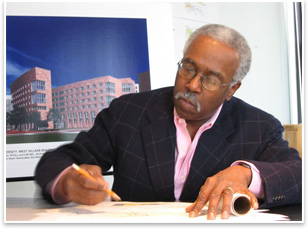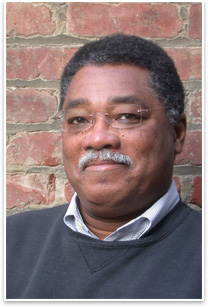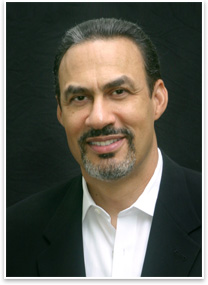
| diversITY Three Contemporary Star Architects Summary: Here, in the third of AIArchitect's Diversity series, are the stories of three African-American architects who founded, own, and lead profitable firms, despite severe hurdles on the road to success. And each is producing high octane design.
M. David Lee, FAIA, cofounder, Stull and Lee Architects, Boston
On private-sector work and typically on public work, too, black-owned firms have to prove themselves every time. Lee remembers in earlier years how frustrated he and partner Donald L. Stull, FAIA, were when they would show a past project to a client prospect, only to have the client ask: “OK, now what part of that project did you do?” He said: "No, we were the architects of record. The whole thing was ours." Lee concedes that with his track record he often gets an easy bye in the first round of selection. Having served as president of the Boston Society of Architects, taught at the Harvard Graduate School of Design, and, along with Stull, having judged a host of design award programs—all this has raised the firm’s profile and made things a little easier. Nonetheless, he points out: “Are we where, perhaps, we should be, given our track record? I'm not certain that we are. If you really look hard, even where we have had breakthroughs—and some of our clients are majority clients—it has been in those places where there was a minority angle in some way, shape, or form.” Work in the majority private sector is still the exception. Michael E. Willis, FAIA, Michael Willis Architects
After time back in St. Louis, then again to San Francisco to start an office there for Fleming, Willis started his own firm in 1988. “Our design approach was to create a place where the solutions were,” he says. He was 37. His firm’s breakthrough came, not surprisingly, through public work. What was surprising was the type: water purification facilities. The Sobrante Ozonation Facility, in El Sobrante, Calif., become the flagship for the district, enticing visitors from the water industry and the general public. Avoiding discussion of the size of his firm (four persons) or its longevity, he concentrated during the selection process on what people who work there need: light and air … a good place to work. That project led to two other water-purification projects, profitable work that earned the money it needed to buy computers, office space, and chairs. Being an expert in such a specialization has its advantages, Willis says. “There’s almost no bar to your being involved if you understand the technology,” he contends. “And because it’s not glamorous, it narrows the field.” Willis approaches community development similarly. He talks to the public client about the way people live. What can you see from the window? How does light and air get into your building? What’s your relationship with the outside from your front door? Philip G. Freelon, FAIA, The Freelon Group
In his first 12 years in practice, he was an associate at 3D/I and, at O’Brien/Atkins Associates in Research Triangle Park, N.C. vice president of architecture and the youngest shareholder. With his own firm, he has received 23 AIA design awards at the regional, state and local levels. When clients visit his offices in the Research Triangle Park, NC, they see the diversity. He presently has a combined staff of 51; 30 percent are people of color. While Freelon concedes he has been more fortunate than many African-American architects regarding commissions from corporate clients, much of the firm’s work still comes from the public sector, and that trying to do innovative work on a limited budget is a challenge. Freelon incorporates African images or symbolism on buildings, only where appropriate, he says: “My roots are in Africa and the branches and leaves grew in America.” He uses jazz as a comparison, where the use of instruments was reconceived to express freedom and creativity. |
||
Copyright 2006 The American Institute of Architects. All rights reserved. Home Page |
||
news headlines
practice
business
design
recent related
› Diversity: The Trailblazers
› Diversity: What the Numbers Tell Us
Next month: minority architects as top partners in majority firms.
Read the full-text story in print-friendly PDF.
Did You Know…
Ground broke this fall for the Pittsburgh Center for African-American Culture, named for Pulitzer Prize winning playwright August Wilson. Architect is Allison Williams, FAIA, a former partner at SOM and later principal at Ai, is now a partner with Perkins + Will.
The newly launched Princeton University Center for African-American Studies for “understanding the impact of race on the life and institutions of the United States” is headed by professor Valerie Smith and includes Kwame Anthony Appiah, who left Harvard for Princeton in a much publicized dispute in 2002.
In a dispute over fees, Wichita, architect Charles McAfee, FAIA, has parted company with the Kansas African-American Museum whose new riverfront home he was to design. He is replaced by Schaefer Johnson Cox Frey & Associates, of Wichita.
As an extra spur to local competition, Moody-Nolan, Inc., one of the nation’s largest black-owned architecture firms and based in Columbus, Ohio, is opening an office in Kansas City.

 Poorer communities generally rely on public sources for funding. “Often the agencies that underwrite these projects impose design requirements that are inflexible and not suited to reinterpretation to fit a particular ethnic culture,” argues Lee. “The HUD requirements we often worked within did not vary whether one was building on a Hopi reservation or in Harlem.”
Poorer communities generally rely on public sources for funding. “Often the agencies that underwrite these projects impose design requirements that are inflexible and not suited to reinterpretation to fit a particular ethnic culture,” argues Lee. “The HUD requirements we often worked within did not vary whether one was building on a Hopi reservation or in Harlem.”
 Freelon’s parents and grandparents were well-educated and gave him a deep appreciation of Modern design. His own education was at Hampton, N.C. State, MIT, and the Harvard GSD, where he was a Loeb Fellow.
Freelon’s parents and grandparents were well-educated and gave him a deep appreciation of Modern design. His own education was at Hampton, N.C. State, MIT, and the Harvard GSD, where he was a Loeb Fellow.